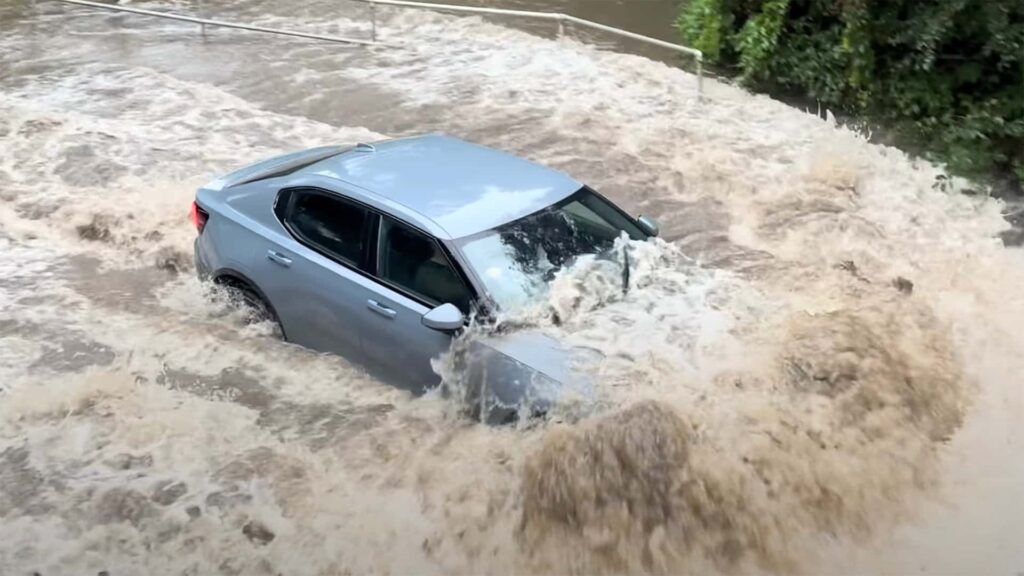Electric vehicles (EVs) have proven to be more resilient in certain situations compared to traditional combustion engine vehicles. One recent example of this was captured on a YouTube channel that showcased a Polestar 2 EV effortlessly driving through deep water without any issues. In contrast, most combustion vehicles attempting the same feat would likely take water into their intake and stall, leaving the drivers stranded.
The video highlighted the advantages of electric motors over combustion engines, particularly in scenarios like high-altitude driving and navigating through flooded roads. While it is not recommended to deliberately drive through deep water, an EV has a higher chance of pushing through without stalling compared to an ICE (Internal Combustion Engine) vehicle. This was evident in the footage from the YouTube channel, Vehicles Vs Water, which showcased the Polestar 2 successfully navigating through a flooded river while other ICE vehicles failed to do so.
The channel features various videos of cars crossing flooded roads in the U.K., where drivers often take the risk of driving through water even when it is too deep. Despite the warnings and risks involved, many drivers choose to test the limits of their vehicles by driving into rivers with the hope of making it to the other side. The Polestar 2, being an electric vehicle, demonstrated its capability by powering through the deep water without any dramatics, unlike the ICE vehicles that quickly stalled and became stranded in the river.
While EVs may provide a better chance of survival in flooded conditions compared to ICE vehicles, it is still important to exercise caution and avoid intentionally driving through deep water. Prolonged exposure to water can lead to potential risks, including the risk of fire. Although EVs are equipped with sealed high-voltage components that minimize the chances of discharge into water, it is best not to take unnecessary risks. Additionally, water intrusion can damage various components of the vehicle, such as wires, electronics, and promote mold growth, even if the car initially survives the water immersion.
In conclusion, while EVs may offer a level of resilience in flooded conditions, it is essential to prioritize safety and avoid driving through deep water whenever possible. The Polestar 2’s successful navigation through the flooded river serves as a testament to the capabilities of electric vehicles, but it also serves as a reminder to exercise caution and avoid unnecessary risks when faced with challenging road conditions. The video above showcases the unfortunate fate of internal combustion cars when faced with the challenges of crossing water bodies. Unlike electric vehicles like the Tesla Cybertruck, which are equipped to handle such scenarios with ease, traditional cars struggle to navigate through flooded areas.
Internal combustion cars rely on engines that combust fuel to generate power, a process that is highly susceptible to damage when exposed to water. Water can seep into the engine and other critical components, causing irreversible damage and potentially rendering the vehicle inoperable. In contrast, electric vehicles like the Tesla Cybertruck utilize electric motors that are sealed and waterproof, making them more resilient in water crossings.
The Tesla Cybertruck, as demonstrated in the video, boasts impressive capabilities when it comes to traversing rivers, lakes, and even seas. With features like a “Wade Mode” that uses air from the suspension to protect the battery, the Cybertruck is designed to handle challenging terrains without compromising performance or safety.
In comparison, the internal combustion cars in the video struggle to make their way through the water, with some even succumbing to the harsh conditions and breaking down. The contrast between the two types of vehicles highlights the advantages of electric vehicles in terms of durability, efficiency, and versatility.
As technology continues to advance, electric vehicles are becoming increasingly popular for their eco-friendly nature and superior performance. The Tesla Cybertruck is a prime example of how innovation in the automotive industry is revolutionizing the way we travel and challenging the limitations of traditional internal combustion vehicles.
In conclusion, the video serves as a stark reminder of the limitations of internal combustion cars when faced with water crossings, while also showcasing the capabilities of electric vehicles like the Tesla Cybertruck. As we look towards a future dominated by sustainable transportation options, it is evident that electric vehicles are leading the way in reshaping the automotive landscape for the better.

